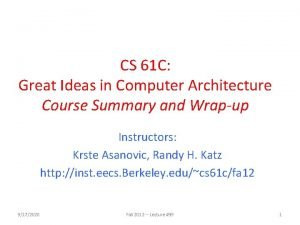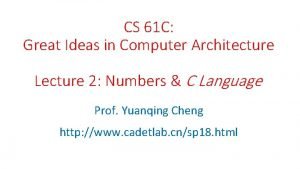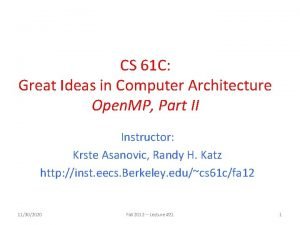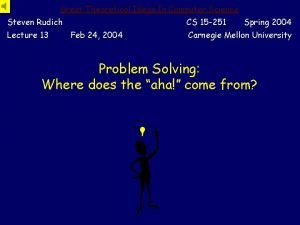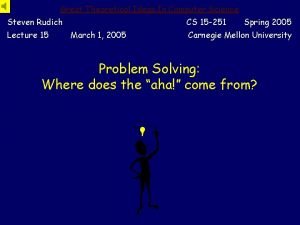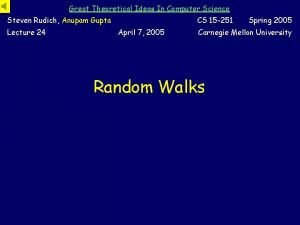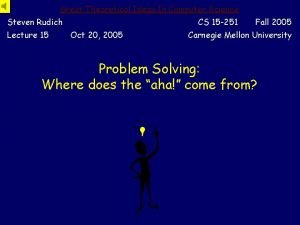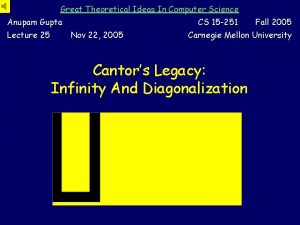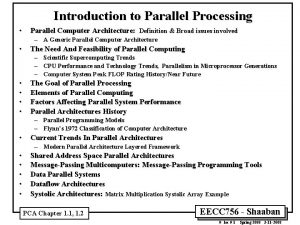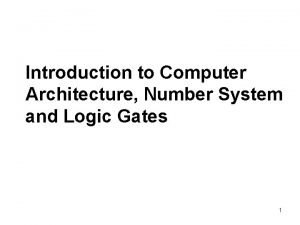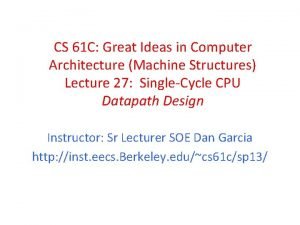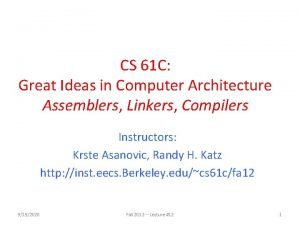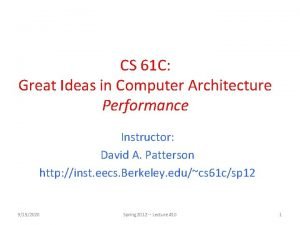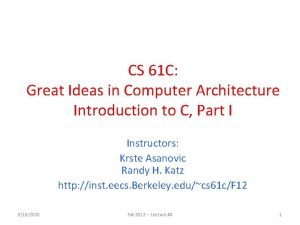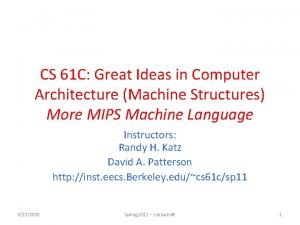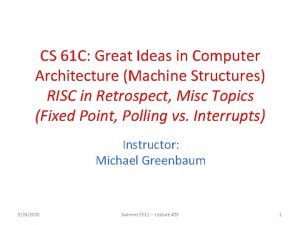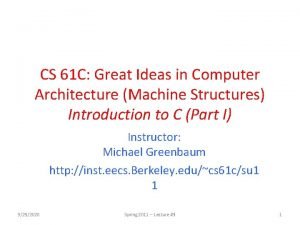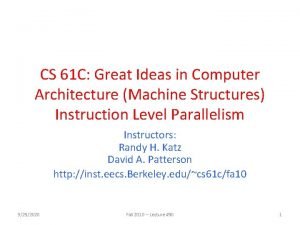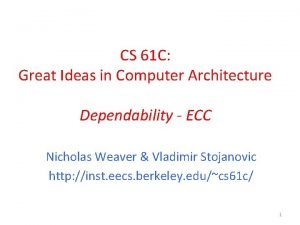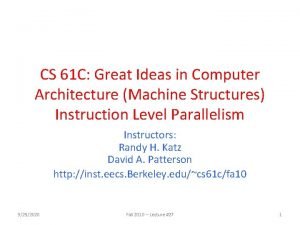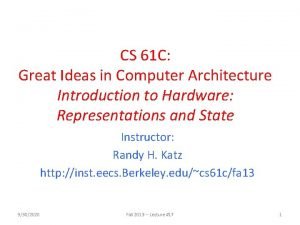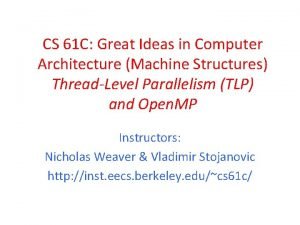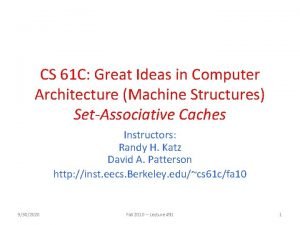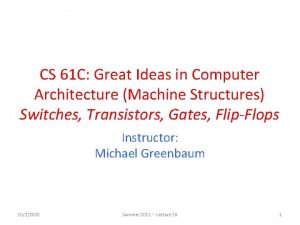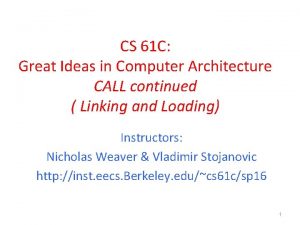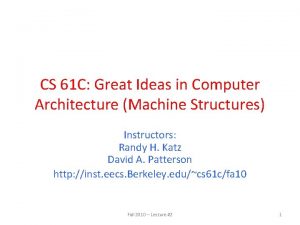CS 61 C Great Ideas in Computer Architecture


































![Parallelize (2) … 1. Compute sum[0]and sum[2] in parallel 2. Compute sum = sum[0] Parallelize (2) … 1. Compute sum[0]and sum[2] in parallel 2. Compute sum = sum[0]](https://slidetodoc.com/presentation_image/5e1eeb76f2a87fb271c164e78b0c5323/image-35.jpg)






















- Slides: 57

CS 61 C: Great Ideas in Computer Architecture Lecture 19: Thread-Level Parallel Processing Bernhard Boser & Randy Katz http: //inst. eecs. berkeley. edu/~cs 61 c

Agenda • MIMD - multiple programs simultaneously • Threads • Parallel programming: Open. MP • Synchronization primitives • Synchronization in Open. MP • And, in Conclusion … CS 61 c Lecture 19: Thread Level Parallel Processing 2

Improving Performance 1. Increase clock rate fs − Reached practical maximum for today’s technology − < 5 GHz for general purpose computers 2. Lower CPI (cycles per instruction) − SIMD, “instruction level parallelism” 3. Perform multiple tasks simultaneously − Multiple CPUs, each executing different program − Tasks may be related Today’s lecture § E. g. each CPU performs part of a big matrix multiplication − or unrelated § E. g. distribute different web http requests over different computers § E. g. run ppt (view lecture slides) and browser (youtube) simultaneously 4. Do all of the above: − High fs, SIMD, multiple parallel tasks CS 61 c Lecture 19: Thread Level Parallel Processing 3

New-School Machine Structures (It’s a bit more complicated!) Software • Parallel Requests Assigned to computer e. g. , Search “Katz” • Parallel Threads Assigned to core e. g. , Lookup, Ads Hardware Harness Parallelism & Achieve High Performance • Parallel Instructions >1 instruction @ one time e. g. , 5 pipelined instructions • Parallel Data Smart Phone Warehouse Scale Computer Memory All gates @ one time CS 61 c • Programming Languages Core (Cache) Input/Output Instruction Unit(s) >1 data item @ one time e. g. , Add of 4 pairs of words • Hardware descriptions … Core Functional Unit(s) A 0+B 0 A 1+B 1 A 2+B 2 A 3+B 3 Cache Memory Project 4 Lecture 19: Thread Level Parallel Processing Logic Gates 4

Parallel Computer Architectures Massive array of computers, fast communication between processors Several separate computers, some means for communication (e. g. Ethernet) GPU “graphics processing unit” CS 61 c Multi-core CPU: 1 datapath in single chip share L 3 cache, memory, peripherals Example: Hive machines 5

Example: CPU with 2 Cores Processor “Core” 1 Control Processor 0 Memory Accesses Datapath PC Memory Input Registers (ALU) Bytes Processor “Core” 2 Control Datapath PC Processor 1 Memory Accesses Output Registers (ALU) CS 61 c I/O-Memory Interfaces 6

Multiprocessor Execution Model • Each processor (core) executes its own instructions • Separate resources (not shared) − Datapath (PC, registers, ALU) − Highest level caches (e. g. 1 st and 2 nd) • Shared resources − Memory (DRAM) − Often 3 rd level cache § Often on same silicon chip § But not a requirement • Nomenclature − “Multiprocessor Microprocessor” − Multicore processor § E. g. 4 core CPU (central processing unit) § Executes 4 different instruction streams simultaneously CS 61 c Lecture 19: Thread Level Parallel Processing 7

Transition to Multicore e d ca e d r e p x , r a % 0 +5 CS 61 c e y r e p 0 0 ~1 Lecture 19: Thread Level Parallel Processing Sequential App Performance 8

Multiprocessor Execution Model • Shared memory − Each “core” has access to the entire memory in the processor − Special hardware keeps caches consistent − Advantages: § Simplifies communication in program via shared variables − Drawbacks: § Does not scale well: o “Slow” memory shared by many “customers” (cores) o May become bottleneck (Amdahl’s Law) • Two ways to use a multiprocessor: − Job-level parallelism § Processors work on unrelated problems § No communication between programs − Partition work of single task between several cores § E. g. each performs part of large matrix multiplication CS 61 c Lecture 19: Thread Level Parallel Processing 9

Parallel Processing • It’s difficult! • It’s inevitable − Only path to increase performance − Only path to lower energy consumption (improve battery life) • In mobile systems (e. g. smart phones, tablets) − Multiple cores − Dedicated processors, e. g. § motion processor in i. Phone § GPU (graphics processing unit) • Warehouse-scale computers − multiple “nodes” § “boxes” with several CPUs, disks per box − MIMD (multi-core) and SIMD (e. g. AVX) in each node CS 61 c Lecture 19: Thread Level Parallel Processing 10

Potential Parallel Performance (assuming software can use it) Year Cores 2003 MIMD 2 2005 +2/ 4 2007 2 yrs 6 2009 8 2011 10 12 12 2013 years 2015 2. 5 X 14 2017 16 2019 18 2021 20 CS 61 c SIMD bits /Core 128 2 X/ 128 4 yrs 128 256 8 X 512 1024 SIMD Core * SIMD bits Total, e. g. FLOPs/Cycle 256 MIMD 4 512 & SIMD 8 768 12 1024 16 2560 40 3072 48 20 X 112 7168 8192 128 18432 288 20480 320 20 x in 12 years 201/12 = 1. 28 x 28% per year or 2 x every 3 years! IF (!) we can use it 11

Agenda • MIMD - multiple programs simultaneously • Threads • Parallel programming: Open. MP • Synchronization primitives • Synchronization in Open. MP • And, in Conclusion … CS 61 c Lecture 19: Thread Level Parallel Processing 12

Programs Running on my Computer PID TTY TIME CMD 220 ? ? 0: 04. 34 /usr/libexec/User. Event. Agent (Aqua) 222 ? ? 0: 10. 60 /usr/sbin/distnoted agent 224 ? ? 0: 09. 11 /usr/sbin/cfprefsd agent 229 ? ? 0: 04. 71 /usr/sbin/usernoted 230 ? ? 0: 02. 35 /usr/libexec/nsurlsessiond 232 ? ? 0: 28. 68 /System/Library/Private. Frameworks/Calendar. Agent. framework/Executables/Calendar. Agent 234 ? ? 0: 04. 36 /System/Library/Private. Frameworks/Game. Center. Foundation. framework/Versions/A/gamed 235 ? ? 0: 01. 90 /System/Library/Core. Services/cloudphotosd. app/Contents/Mac. OS/cloudphotosd 236 ? ? 0: 49. 72 /usr/libexec/secinitd 239 ? ? 0: 01. 66 /System/Library/Private. Frameworks/TCC. framework/Resources/tccd 240 ? ? 0: 12. 68 /System/Library/Frameworks/Accounts. framework/Versions/A/Support/accountsd 241 ? ? 0: 09. 56 /usr/libexec/Safari. Cloud. History. Push. Agent 242 ? ? 0: 00. 27 /System/Library/Private. Frameworks/Call. History. framework/Support/Call. History. Sync. Helper 243 ? ? 0: 00. 74 /System/Library/Core. Services/mapspushd 244 ? ? 0: 00. 79 /usr/libexec/fmfd 246 ? ? 0: 00. 09 /System/Library/Private. Frameworks/Ask. Permission. framework/Versions/A/Resources/askpermissiond 248 ? ? 0: 01. 03 /System/Library/Private. Frameworks/Cloud. Docs. Daemon. framework/Versions/A/Support/bird 249 ? ? 0: 02. 50 /System/Library/Private. Frameworks/IDS. framework/identityservicesd. app/Contents/Mac. OS/identityservicesd 250 ? ? 0: 04. 81 /usr/libexec/secd 254 ? ? 0: 24. 01 /System/Library/Private. Frameworks/Cloud. Kit. Daemon. framework/Support/cloudd 258 ? ? 0: 04. 73 /System/Library/Private. Frameworks/Telephony. Utilities. framework/callservicesd 267 ? ? 0: 02. 15 /System/Library/Core. Services/Air. Play. UIAgent. app/Contents/Mac. OS/Air. Play. UIAgent --launchd 271 ? ? 0: 03. 91 /usr/libexec/nsurlstoraged 274 ? ? 0: 00. 90 /System/Library/Private. Frameworks/Commerce. Kit. framework/Versions/A/Resources/storeaccountd 282 ? ? 0: 00. 09 /usr/sbin/pboard 283 ? ? 0: 00. 90 /System/Library/Private. Frameworks/Internet. Accounts. framework/Versions/A/XPCServices/com. apple. internetaccounts. xpc/Contents/Mac. OS/com. apple. internetaccounts 285 ? ? 0: 04. 72 /System/Library/Frameworks/Application. Services. framework/Frameworks/ATS. framework/Support/fontd 291 ? ? 0: 00. 25 /System/Library/Frameworks/Security. framework/Versions/A/Resources/Cloud. Keychain. Proxy. bundle/Contents/Mac. OS/Cloud. Keychain. Proxy 292 ? ? 0: 09. 54 /System/Library/Core. Services. UIAgent. app/Contents/Mac. OS/Core. Services. UIAgent 293 ? ? 0: 00. 29 /System/Library/Private. Frameworks/Cloud. Photo. Services. framework/Versions/A/Frameworks/Cloud. Photo. Services. Configuration. framework/Versions/A/XPCServices/com. apple. Cloud. Photos. Configuration. xpc/Content s/Mac. OS/com. apple. Cloud. Photos. Configuration 297 ? ? 0: 00. 84 /System/Library/Private. Frameworks/Cloud. Services. framework/Resources/com. apple. sbd 302 ? ? 0: 26. 11 /System/Library/Core. Services/Dock. app/Contents/Mac. OS/Dock 303 ? ? 0: 09. 55 / System/Library/Core. Services/System. UIServer. app/Contents/Mac. OS/System. UIServer … 156 total at this moment How does my laptop do this? Imagine doing 156 assignments all at the same time! CS 61 c Lecture 19: Thread Level Parallel Processing 13

Threads • Sequential flow of instructions that performs some task − Up to now we just called this a “program” • Each thread has a − Dedicated PC (program counter) − Separate registers − Accesses the shared memory • Each processor provides one (or more) − hardware threads (or harts) that actively execute instructions − Each core executes one “hardware thread” • Operating system multiplexes multiple − software threads onto the available hardware threads − all threads except those mapped to hardware threads are waiting CS 61 c Lecture 19: Thread Level Parallel Processing 14

Operating System Threads Give illusion of many “simultaneously” active threads 1. Multiplex software threads onto hardware threads: a) b) Switch out blocked threads (e. g. cache miss, user input, network access) Timer (e. g. switch active thread every 1 ms) 2. Remove a software thread from a hardware thread by i. ii. interrupting its execution saving its registers and PC to memory 3. Start executing a different software thread by i. ii. CS 61 c loading its previously saved registers into a hardware thread’s registers jumping to its saved PC Lecture 19: Thread Level Parallel Processing 15

Example: 4 Cores Thread pool: List of threads competing for processor OS maps threads to cores and schedules logical (software) threads Core 1 Core 2 Core 3 Core 4 Each “Core” actively runs 1 program at a time CS 61 c Lecture 19: Thread Level Parallel Processing 16

Multithreading • Typical scenario: − Active thread encounters cache miss − Active thread waits ~ 1000 cycles for data from DRAM − switch out and run different thread until data available • Problem − Must save current thread state and load new thread state § PC, all registers (could be many, e. g. AVX) − must perform switch in ≪ 1000 cycles • Can hardware help? − Moore’s law: transistors are plenty CS 61 c Lecture 19: Thread Level Parallel Processing 17

Hardware assisted Software Multithreading Processor (1 Core, 2 Threads) Control Datapath PC 0 Memory PC 1 Registers 0 Registers 1 Bytes (ALU) • Two copies of PC and Registers inside processor hardware • Looks like two processors to software (hardware thread 0, hardware thread 1) • Hyperthreading: • Both threads may be active simultaneously Note: presented incorrectly in the lecture CS 61 c Input Lecture 19: Thread Level Parallel Processing Output I/O-Memory Interfaces 18

Multithreading • Logical threads − ≈ 1% more hardware, ≈ 10% (? ) better performance § Separate registers § Share datapath, ALU(s), caches • Multicore − => Duplicate Processors − ≈50% more hardware, ≈2 X better performance? • Modern machines do both − Multiple cores with multiple threads per core CS 61 c Lecture 19: Thread Level Parallel Processing 19

Bernhard’s Laptop $ sysctl -a | grep hw hw. physicalcpu: hw. logicalcpu: hw. l 1 icachesize: hw. l 1 dcachesize: hw. l 2 cachesize: hw. l 3 cachesize: 2 4 32, 768 262, 144 3, 145, 728 • 2 Cores • 4 Threads total CS 61 c Lecture 19: Thread Level Parallel Processing 20

Example: 6 Cores, 24 Logical Threads Thread pool: List of threads competing for processor OS maps threads to cores and schedules logical (software) threads Core 1 Thread 1 Core 2 Thread 1 Core 3 Thread 1 Core 4 Thread 1 Core 5 Thread 1 Core 6 Thread 1 Thread 2 Thread 2 Thread 3 Thread 3 Thread 4 Thread 4 4 Logical threads per core (hardware) thread CS 61 c Lecture 19: Thread Level Parallel Processing 21

Agenda • MIMD - multiple programs simultaneously • Threads • Parallel programming: Open. MP • Synchronization primitives • Synchronization in Open. MP • And, in Conclusion … CS 61 c Lecture 19: Thread Level Parallel Processing 22

Languages supporting Parallel Programming Actor. Script Ada Afnix Alef Alice APL Axum Chapel Cilk Clean Clojure Concurrent C Concurrent Pascal Concurrent ML Concurrent Haskell Curry CUDA E Eiffel Erlang Fortan 90 Go Io Janus Jo. Caml Join Java Joule Joyce Lab. VIEW Limbo Linda Multi. Lisp Modula-3 Occam occam-π Orc Oz Pict Reia SALSA Scala SISAL SR Stackless Python Super. Pascal VHDL XC Which one to pick? CS 61 c Lecture 19: Thread Level Parallel Processing 23

Why so many parallel programming languages? • Piazza question: − Why “intrinsics”? − TO Intel: fix your #()&$! Compiler! • It’s happening. . . but − SIMD features are continually added to compilers (Intel, gcc) − Intense area of research − Research progress: § 20+ years to translate C into good (fast!) assembly § How long to translate C into good (fast!) parallel code? o General problem is very hard to solve o Present state: specialized solutions for specific cases o Your opportunity to become famous! CS 61 c Lecture 19: Thread Level Parallel Processing 24

Parallel Programming Languages • Number of choices is indication of − No universal solution § Needs are very problem specific − E. g. § Scientific computing (matrix multiply) § Webserver: handle many unrelated requests simultaneously § Input / output: it’s all happening simultaneously! • Specialized languages for different tasks − Some are easier to use (for some problems) − None is particularly ”easy” to use • 61 C − Parallel language examples for high-performance computing − Open. MP CS 61 c Lecture 19: Thread Level Parallel Processing 25

Parallel Loops • Serial execution: for (int i=0; i<100; i++) { … } • Parallel Execution: for (int i=0; i<25; i++) { … } CS 61 c for (int i=25; i<50; i++) { … } for (int i=50; i<75; i++) { … } Lecture 19: Thread Level Parallel Processing for (int i=75; i<100; i++) { … } 26

Parallel for in Open. MP #include <omp. h> #pragma omp parallel for (int i=0; i<100; i++) { … } CS 61 c Lecture 19: Thread Level Parallel Processing 27

Open. MP Example $ gcc-5 -fopenmp for. c; . /a. out thread 0, i = 0 thread 1, i = 3 thread 2, i = 6 thread 3, i = 8 thread 0, i = 1 thread 1, i = 4 thread 2, i = 7 thread 3, i = 9 thread 0, i = 2 thread 1, i = 5 01 02 03 14 15 16 27 28 39 40 CS 61 c Lecture 19: Thread Level Parallel Processing 28

Open. MP • C extension: no new language to learn • Multi-threaded, shared-memory parallelism − Compiler Directives, #pragma − Runtime Library Routines, #include <omp. h> • #pragma − Ignored by compilers unaware of Open. MP − Same source for multiple architectures § E. g. same program for 1 & 16 cores • Only works with shared memory CS 61 c Lecture 19: Thread Level Parallel Processing 29

Open. MP Programming Model • Fork - Join Model: • Open. MP programs begin as single process (master thread) − Sequential execution • When parallel region is encountered − Master thread “forks” into team of parallel threads − Executed simultaneously − At end of parallel region, parallel threads ”join”, leaving only master thread • Process repeats for each parallel region − Amdahl’s law? CS 61 c Lecture 19: Thread Level Parallel Processing 30

What Kind of Threads? • Open. MP threads are operating system (software) threads. • OS will multiplex requested Open. MP threads onto available hardware threads. • Hopefully each gets a real hardware thread to run on, so no OS-level time-multiplexing. • But other tasks on machine can also use hardware threads! • Be “careful” (? ) when timing results for project 4! − 5 AM? − Job queue? CS 61 c Lecture 19: Thread Level Parallel Processing 31

Example 2: computing p CS 61 c http: //openmp. org/mp-documents/omp-hands-on-SC 08. pdf 32

Sequential p pi = 3. 142425985001 • Resembles p, but not very accurate • Let’s increase num_steps and parallelize CS 61 c Lecture 19: Thread Level Parallel Processing 33

Parallelize (1) … • Problem: each threads needs access to the shared variable sum • Code runs sequentially … CS 61 c Lecture 19: Thread Level Parallel Processing 34
![Parallelize 2 1 Compute sum0and sum2 in parallel 2 Compute sum sum0 Parallelize (2) … 1. Compute sum[0]and sum[2] in parallel 2. Compute sum = sum[0]](https://slidetodoc.com/presentation_image/5e1eeb76f2a87fb271c164e78b0c5323/image-35.jpg)
Parallelize (2) … 1. Compute sum[0]and sum[2] in parallel 2. Compute sum = sum[0] + sum[1] sequentially sum[0] CS 61 c sum[1] Lecture 19: Thread Level Parallel Processing 35

Parallel p CS 61 c Lecture 19: Thread Level Parallel Processing 36

Trial Run i = 1, id = 1 i = 0, id = 0 i = 2, id = 2 i = 3, id = 3 i = 5, id = 1 i = 4, id = 0 i = 6, id = 2 i = 7, id = 3 i = 9, id = 1 i = 8, id = 0 pi = 3. 142425985001 CS 61 c Lecture 19: Thread Level Parallel Processing 37

Scale up: num_steps = 106 pi = 3. 141592653590 You verify how many digits are correct … CS 61 c Lecture 19: Thread Level Parallel Processing 38

Can we Parallelize Computing sum Always looking for ways to beat Amdahl’s Law … Summation inside parallel section • Insignificant speedup in this example, but … • pi = 3. 138450662641 • Wrong! And value changes between runs? ! • What’s going on? CS 61 c Lecture 19: Thread Level Parallel Processing 39

Your Turn What are the possible values of *($s 0) after executing this code by 2 concurrent threads? Answer A B C CS 61 c D E # *($s 0) = 100 lw $t 0, 0($s 0) addi $t 0, 1 sw $t 0, 0($s 0) *($s 0) 100 or 101 101 or 102 100 or Level 101 Parallel or. Processing 102 or 103 Lecture 19: Thread 40

Your Turn What are the possible values of *($s 0) after executing this code by 2 concurrent threads? # *($s 0) = 100 lw $t 0, 0($s 0) addi $t 0, 1 sw $t 0, 0($s 0) Answer *($s 0) C 101 or 102 • 102 if the threads enter code section sequentially • 101 if both execute lw before either runs sw • one thread sees “stale” data CS 61 c Lecture 19: Thread Level Parallel Processing 41

What’s going on? CS 61 c • Operation is really pi = pi + sum[id] • What if >1 threads current (same) value of pi, computes the sum, and stores the result back to pi? • Each processor reads same intermediate value of pi! • Result depends on who gets there when • A “race” result is not deterministic 42 Lecture 19: Thread Level Parallel Processing

Agenda • MIMD - multiple programs simultaneously • Threads • Parallel programming: Open. MP • Synchronization primitives • Synchronization in Open. MP • And, in Conclusion … CS 61 c Lecture 19: Thread Level Parallel Processing 43

Synchronization • Problem: − Limit access to shared resource to 1 actor at a time − E. g. only 1 person permitted to edit a file at a time § otherwise changes by several people get all mixed up • Solution: • Take turns: • Only one person get’s the microphone & talks at a time • Also good practice for classrooms, btw … CS 61 c Lecture 19: Thread Level Parallel Processing 44

Locks • Computers use locks to control access to shared resources − Serves purpose of microphone in example − Also referred to as “semaphore” • Usually implemented with a variable − int lock; § 0 for unlocked § 1 for locked CS 61 c Lecture 19: Thread Level Parallel Processing 45

Synchronization with locks // wait for lock released while (lock != 0) ; // lock == 0 now (unlocked) // set lock = 1; // access shared resource. . . // e. g. pi // sequential execution! (Amdahl. . . ) // release lock = 0; CS 61 c Lecture 19: Thread Level Parallel Processing 46

Lock Synchronization Thread 1 Thread 2 while (lock != 0) ; lock = 1; • Thread 2 finds lock not set, before thread 1 sets it • Both threads believe they got and set the lock! // critical section lock = 1; Try as you want, this problem has no solution, // critical section not even at the assembly level. lock = 0; Unless we introduce new instructions, that is! CS 61 c Lecture 19: Thread Level Parallel Processing 47

Hardware Synchronization • Solution: − Atomic read/write − Read & write in single instruction § No other access permitted between read and write − Note: § Must use shared memory (multiprocessing) • Common implementations: − Atomic swap of register ↔ memory − Pair of instructions for “linked” read and write § write fails if memory location has been “tampered” with after linked read § MIPS uses this solution CS 61 c Lecture 19: Thread Level Parallel Processing 48

MIPS Synchronization Instructions • Load linked: ll $rt, off($rs) − Reads memory location (like lw) − Also sets (hidden) “link bit” − Link bit is reset if memory location (off($rs)) is accessed • Store conditional: sc $rt, off($rs) − Stores off($rs) = $rt (like sw) − Sets $rt=1 (success) if link bit is set § i. e. no (other) process accessed off($rs) since ll − Sets $rt=0 (failure) otherwise − Note: sc clobbers $rt, i. e. changes its value CS 61 c Lecture 19: Thread Level Parallel Processing 49

Lock Synchronization $t 0 = 1 before calling ll: minimize time between ll and sc Broken Synchronization while (lock != 0) ; lock = 1; // critical section lock = 0; CS 61 c Fix (lock is at location $s 1) Try: addiu $t 0, $zero, 1 ll $t 1, 0($s 1) Try again if sc failed bne $t 1, $zero, Try (another thread executed sc $t 0, 0($s 1) sc since above ll) beq $t 0, $zero, Try Locked: # critical section Unlock: sw $zero, 0($s 1) Lecture 19: Thread Level Parallel Processing 50

Agenda • MIMD - multiple programs simultaneously • Threads • Parallel programming: Open. MP • Synchronization primitives • Synchronization in Open. MP • And, in Conclusion … CS 61 c Lecture 19: Thread Level Parallel Processing 51

Open. MP Locks CS 61 c Lecture 19: Thread Level Parallel Processing 52

Synchronization in Open. MP • Typically are used in libraries of higher level parallel programming constructs • E. g. Open. MP offers $pragmas for common cases: − critical − atomic − barrier − ordered • Open. MP offers many more features − see online documentation − or tutorial at § http: //openmp. org/mp-documents/omp-hands-on-SC 08. pdf CS 61 c Lecture 19: Thread Level Parallel Processing 53

Open. MP critical CS 61 c Lecture 19: Thread Level Parallel Processing 54

The Trouble with Locks … • … is dead-locks • Consider 2 cooks sharing a kitchen − Each cooks a meal that requires salt and pepper (locks) − Cook 1 grabs salt − Cook 2 grabs pepper − Cook 1 notices s/he needs pepper § it’s not there, so s/he waits − Cook 2 realizes s/he needs salt § it’s not there, so s/he waits • A not so common cause of cook starvation − But deadlocks are possible in parallel programs − Very difficult to debug § malloc/free is easy … CS 61 c Lecture 19: Thread Level Parallel Processing 55

Agenda • MIMD - multiple programs simultaneously • Threads • Parallel programming: Open. MP • Synchronization primitives • Synchronization in Open. MP • And, in Conclusion … CS 61 c Lecture 19: Thread Level Parallel Processing 56

And in Conclusion, … • Sequential software execution speed is limited • Parallel processing is the only path to higher performance − SIMD: instruction level parallelism § Implemented in all high performance CPUs today (x 86, ARM, …) § Partially supported by compilers − MIMD: thread level parallelism § Multicore processors § Supported by Operating Systems (OS) § Requires programmer intervention to exploit at single program level o E. g. Open. MP − SIMD & MIMD for maximum performance • Synchronization − Requires hardware support: specialized assembly instructions − Typically use higher-level support − Beware of deadlocks CS 61 c Lecture 19: Thread Level Parallel Processing 57
 8 great ideas of computer architecture
8 great ideas of computer architecture Cs61c fall 2020
Cs61c fall 2020 Cs61c
Cs61c 8 great ideas in computer architecture
8 great ideas in computer architecture Great theoretical ideas in computer science
Great theoretical ideas in computer science Great ideas in theoretical computer science
Great ideas in theoretical computer science Great theoretical ideas in computer science
Great theoretical ideas in computer science Great ideas in computer science
Great ideas in computer science Great theoretical ideas in computer science
Great theoretical ideas in computer science Great theoretical ideas in computer science
Great theoretical ideas in computer science Great theoretical ideas in computer science
Great theoretical ideas in computer science Great theoretical ideas in computer science
Great theoretical ideas in computer science Vocabularize
Vocabularize Great theoretical ideas in computer science
Great theoretical ideas in computer science Great theoretical ideas in computer science
Great theoretical ideas in computer science Three bus architecture
Three bus architecture Difference between computer architecture and organisation
Difference between computer architecture and organisation Simple computer design
Simple computer design Ideas have consequences bad ideas have victims
Ideas have consequences bad ideas have victims Los deseos ridículos preguntas y respuestas
Los deseos ridículos preguntas y respuestas Unit 4 great ideas
Unit 4 great ideas Turning great strategy into great performance
Turning great strategy into great performance South dakota state animal
South dakota state animal Great power comes with great responsibility
Great power comes with great responsibility Great white shark vs hammerhead shark
Great white shark vs hammerhead shark Did alexander the great deserve to be called great
Did alexander the great deserve to be called great Enlightened despot
Enlightened despot With great expectations comes great responsibility
With great expectations comes great responsibility A great deal vs a great many
A great deal vs a great many With great power comes great responsibility
With great power comes great responsibility Does alexander deserve to be called the great
Does alexander deserve to be called the great Great is thy faithfulness o lord my father
Great is thy faithfulness o lord my father Architecture business cycle activities
Architecture business cycle activities Call and return architecture
Call and return architecture What is product architecture
What is product architecture Product architecture
Product architecture Computer organization and architecture 10th solution
Computer organization and architecture 10th solution Computer architecture 101
Computer architecture 101 Coa virtual lab iit kharagpur
Coa virtual lab iit kharagpur Introduction to computer organization and architecture
Introduction to computer organization and architecture Timing and control in computer architecture
Timing and control in computer architecture Evolution of computer architecture
Evolution of computer architecture Dma controller in computer architecture
Dma controller in computer architecture Floating point division algorithm in computer architecture
Floating point division algorithm in computer architecture Wipro
Wipro Chordal ring
Chordal ring Smt computer architecture
Smt computer architecture Pseudo
Pseudo Collision prevention in computer architecture
Collision prevention in computer architecture Instruction format in computer architecture
Instruction format in computer architecture Nano programming in computer architecture
Nano programming in computer architecture What is microprogram sequencer
What is microprogram sequencer Memory system design in computer architecture
Memory system design in computer architecture Dram memory mapping
Dram memory mapping Linear and nonlinear pipeline
Linear and nonlinear pipeline Computer architecture definition
Computer architecture definition Parallel processing architecture
Parallel processing architecture Computer architecture number system
Computer architecture number system

